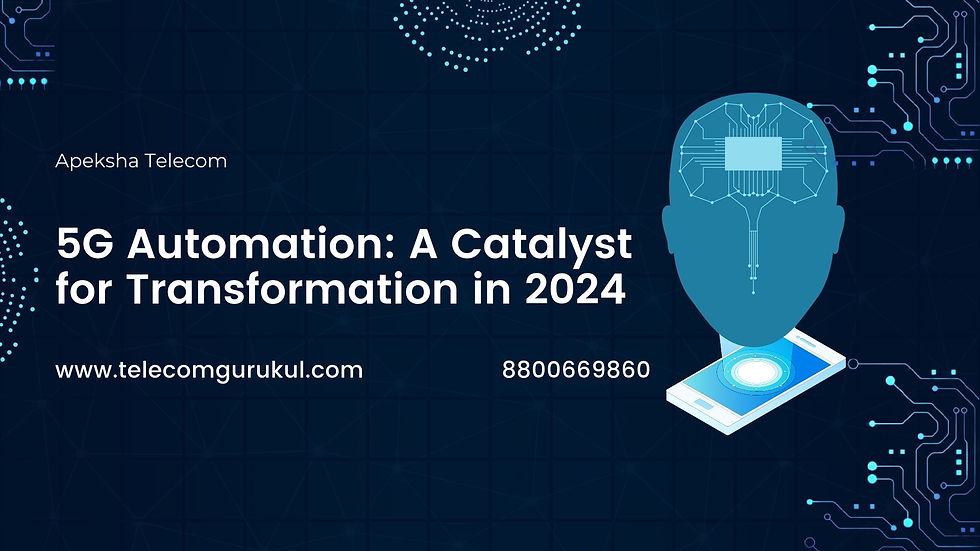5G Automation: A Catalyst for Transformation in 2024
- K Supriya
- Jun 25, 2024
- 7 min read

In the ever-evolving landscape of technology, 5G automation stands out as a significant catalyst for transformation in 2024. As industries strive to innovate and improve efficiency, the synergy of 5G technology with artificial intelligence (AI) and cloud computing is reshaping the way we operate and interact with the world. This article delves into the multifaceted impact of 5G automation, exploring its potential to revolutionize various sectors and drive unprecedented growth.
Table of Contents
Introduction to 5G Automation
The Synergy of 5G, AI, and Cloud Computing
Transformative Impacts on Key Industries
Enhancing Efficiency and Productivity
Telecom Gurukul: Pioneering Education and Placement in 5G Technology
Apeksha Telecom: Integrating AI and Cloud with 5G
Future Prospects and Challenges
Conclusion
Introduction to 5G Automation
5G technology, the fifth generation of mobile networks, offers unprecedented speed, low latency, and massive connectivity. When combined with automation, it becomes a powerful tool that enables machines, devices, and systems to operate autonomously and efficiently. In 2024, the integration of 5G automation is set to transform various sectors, enhancing productivity, reducing costs, and fostering innovation.
The Synergy of 5G, AI, and Cloud Computing
Understanding 5G Technology
5G technology is designed to deliver faster data speeds, lower latency, and more reliable connections compared to its predecessors. Its ability to connect a vast number of devices simultaneously makes it ideal for supporting the Internet of Things (IoT), smart cities, and advanced industrial applications.
Role of AI in Automation
Artificial intelligence (AI) is the driving force behind automation. AI algorithms enable machines to learn from data, make decisions, and perform tasks that traditionally required human intervention. When combined with 5G, AI can process real-time data from connected devices, leading to smarter and more efficient systems.
Cloud Computing: The Backbone of Modern Automation
Cloud computing provides the infrastructure needed to store, process, and analyze the vast amounts of data generated by 5G-enabled devices. It offers scalable resources and computational power, making it possible to implement complex AI algorithms and automation processes. The integration of 5G, AI, and cloud computing creates a robust ecosystem that supports seamless automation across various applications.
Transformative Impacts on Key Industries
Manufacturing
Smart Factories
5G automation is revolutionizing the manufacturing sector by enabling the development of smart factories. These factories leverage IoT devices, AI, and cloud computing to optimize production processes, monitor equipment in real-time, and predict maintenance needs. This results in increased efficiency, reduced downtime, and higher product quality.
Robotics and Automation
The combination of 5G and AI allows for the deployment of advanced robotics in manufacturing. These robots can perform complex tasks with precision and adaptability, leading to higher productivity and lower operational costs. The real-time data processing
capabilities of 5G enable robots to respond swiftly to changes in the production environment.
Healthcare
Remote Surgery and Telemedicine
In the healthcare sector, 5G automation is enhancing remote surgery and telemedicine. The low latency and high reliability of 5G networks enable surgeons to perform complex procedures from a distance, using robotic instruments. Additionally, telemedicine applications benefit from real-time video consultations and remote monitoring of patients, improving access to healthcare services.
Smart Medical Devices
Smart medical devices, connected via 5G, can continuously monitor patient health and transmit data to healthcare providers. AI algorithms analyze this data to detect anomalies and provide timely interventions. This leads to better patient outcomes and more efficient healthcare delivery.
Transportation and Logistics
Autonomous Vehicles
5G automation is a key enabler of autonomous vehicles. The low latency and high bandwidth of 5G networks allow these vehicles to communicate with each other and with infrastructure in real-time. This improves safety, reduces traffic congestion, and enhances the efficiency of transportation systems.
Supply Chain Optimization
In logistics, 5G automation facilitates real-time tracking and monitoring of shipments. AI-powered analytics optimize supply chain operations, reducing delays and improving inventory management. This leads to cost savings and better customer satisfaction.
Smart Cities
Urban Planning and Infrastructure
Smart cities leverage 5G automation to enhance urban planning and infrastructure management. Real-time data from IoT sensors is used to monitor traffic, manage utilities, and improve public services. AI algorithms analyze this data to optimize resource allocation and enhance the quality of life for residents.
Public Safety and Security
5G-enabled surveillance systems and AI-driven analytics enhance public safety and security in smart cities. Real-time monitoring and analysis of video feeds allow for quick response to incidents and proactive crime prevention. This results in safer urban environments and better law enforcement.
Enhancing Efficiency and Productivity
The integration of 5G automation in various sectors leads to significant improvements in efficiency and productivity. Real-time data processing and AI-driven decision-making enable organizations to optimize operations, reduce waste, and enhance overall performance. This section explores how 5G automation is driving efficiency across different domains.
Predictive Maintenance
Predictive maintenance is a critical application of 5G automation. By continuously monitoring equipment and analyzing data, AI algorithms can predict when maintenance is needed, preventing costly breakdowns and minimizing downtime. This approach is particularly valuable in industries such as manufacturing, transportation, and energy.
Manufacturing: In the manufacturing sector, predictive maintenance ensures that machinery and equipment are always in optimal condition. Sensors and IoT devices collect data on equipment performance, which is then analyzed in real-time using AI algorithms. This allows for early detection of potential issues, reducing unplanned downtime and maintenance costs. As a result, manufacturers can maintain high levels of productivity and efficiency.
Transportation: In the transportation industry, predictive maintenance helps keep vehicles and infrastructure in top shape. For example, in aviation, sensors on aircraft can monitor the health of various components, predicting failures before they occur. This not only enhances safety but also ensures that aircraft are available for service more consistently, improving overall operational efficiency.
Energy: In the energy sector, predictive maintenance is used to monitor critical infrastructure such as power plants and grid components. By predicting failures and scheduling maintenance proactively, energy companies can avoid outages and ensure a stable supply of electricity. This is particularly important for integrating renewable energy sources, which can be more variable than traditional energy sources.
Workforce Augmentation
5G automation also augments the capabilities of the workforce. AI-powered tools and applications assist employees in performing their tasks more efficiently and accurately. This not only improves productivity but also enhances job satisfaction and safety.
Telecom Gurukul: Pioneering Education and Placement in 5G Technology
Telecom Gurukul is at the forefront of education and training in 5G technology. As a leading institution, it offers comprehensive courses that cover the latest advancements in 5G, AI, and cloud computing. Telecom Gurukul's programs are designed to equip students with the skills and knowledge needed to excel in the rapidly evolving tech landscape.
Placement Opportunities
One of the key strengths of Telecom Gurukul is its commitment to student placement. The institution has a strong track record of securing 100% placement for its graduates, thanks to its industry partnerships and focus on practical training. Students benefit from exposure to real-world projects and internships, which enhance their employability and career prospects.
Industry Collaboration
Telecom Gurukul collaborates with leading tech companies to ensure its curriculum remains relevant and up-to-date. This collaboration provides students with valuable insights into industry trends and challenges, preparing them for successful careers in 5G technology and related fields.
Apeksha Telecom: Integrating AI and Cloud with 5G
Apeksha Telecom is another prominent institution that plays a crucial role in integrating AI and cloud computing with 5G technology. The institution offers specialized courses that focus on the convergence of these technologies, providing students with a holistic understanding of their applications and impact.
Comprehensive Training Programs
Apeksha Telecom's training programs cover a wide range of topics, including 5G networks, AI algorithms, and cloud infrastructure. The institution's hands-on approach ensures that students gain practical experience and develop the skills needed to implement and manage 5G automation solutions.
Focus on Innovation
Innovation is at the core of Apeksha Telecom's mission. The institution encourages students to explore new ideas and develop innovative solutions that leverage the power of 5G, AI, and cloud computing. This fosters a culture of creativity and problem-solving, preparing graduates to drive technological advancements in their careers.
Future Prospects and Challenges
While the potential of 5G automation is immense, there are also challenges that need to be addressed to fully realize its benefits. This section explores the future prospects of 5G automation and the hurdles that must be overcome.
Technological Advancements
Continuous advancements in 5G technology, AI, and cloud computing will drive the future of automation. As these technologies evolve, they will unlock new possibilities and applications, further enhancing efficiency and productivity across various sectors.
Regulatory and Security Concerns
Regulatory and security concerns are significant challenges that must be addressed. The deployment of 5G networks and the widespread use of AI raise issues related to data privacy, cybersecurity, and regulatory compliance. Ensuring robust security measures and adhering to regulatory standards will be crucial for the successful implementation of 5G automation.
Workforce Adaptation
The integration of 5G automation will require the workforce to adapt to new roles and responsibilities. Continuous learning and reskilling will be essential to keep pace with technological advancements. Institutions like Telecom Gurukul and Apeksha Telecom play a vital role in providing the necessary education and training to prepare the workforce for the future.
Conclusion
In 2024, 5G automation is poised to be a catalyst for transformation across various industries. The synergy of 5G technology, AI, and cloud computing is driving unprecedented growth and innovation, enhancing efficiency, and improving the quality of life. As we navigate the future, it is essential to address the challenges and leverage the opportunities presented by 5G automation to build a smarter, more connected world.
For more information on 5G technology and related courses, visit Telecom Gurukul and Apeksha Telecom. To learn about the latest advancements in 5G, AI, and cloud computing, explore these external resources:
Internal URLs
External URLs
GSMA - The 5G Guide





Comments